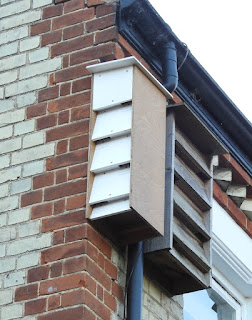When it was suggested to Richard Porter, a Cley resident and Trevor Williams an energetic volunteer with the Norfolk Wildlife Trust that it might be a good idea to have Swift boxes on the visitor centre, they quickly responded by getting approval from the powers that be.
However, when we came to look for suitable places for Swift boxes, there was nowhere that was ideally suited. We originally thought that the Simon Aspinall Education Centre would be the most appropriate - Simon was a great fan of Swifts, and would have loved the idea. However, it is adjacent to the public area where people have their picnics in the summer, so attraction calls so close might not be appreciated by all visitors. Also the building is quite exposed.
As a result we settled on the Dick Bagnall-Oakeley Centre, an attractive thatched building, clad in timber and with broad eaves. However, the eaves are only 2.8 metres high. Although this is well below our very minimum recommendation (~3.5 metres), Swifts are known to nest at this height and lower. (see here and here) The ground in front of the building slopes away from the building, overlooking Cley Marsh, so this might help
.
The net result is that we installed 4 Model 30's supplied by John Stimpson. The geometric shape of the Model 30 fitted the underside of the eaves perfectly.
Should this plan succeed in attracting Swifts, then there is scope to expand to double or treble the number of boxes.
We regard this project as pushing the boundaries - although it challenges our own advice, it may tell us something.
However, when we came to look for suitable places for Swift boxes, there was nowhere that was ideally suited. We originally thought that the Simon Aspinall Education Centre would be the most appropriate - Simon was a great fan of Swifts, and would have loved the idea. However, it is adjacent to the public area where people have their picnics in the summer, so attraction calls so close might not be appreciated by all visitors. Also the building is quite exposed.
As a result we settled on the Dick Bagnall-Oakeley Centre, an attractive thatched building, clad in timber and with broad eaves. However, the eaves are only 2.8 metres high. Although this is well below our very minimum recommendation (~3.5 metres), Swifts are known to nest at this height and lower. (see here and here) The ground in front of the building slopes away from the building, overlooking Cley Marsh, so this might help
.
 |
| Trevor Willlams installing a Model 30 Photo Richard Porter |
Should this plan succeed in attracting Swifts, then there is scope to expand to double or treble the number of boxes.
We regard this project as pushing the boundaries - although it challenges our own advice, it may tell us something.
 |
| Trevor Williams and Richard Porter with 4 Model 30 nest boxes |















